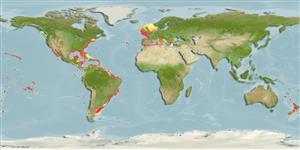Turritopsis nutricula Mccrady, 1859
Immortal jellyfish| Native range | All suitable habitat | Point map | Year 2050 |

|
| This map was computer-generated and has not yet been reviewed. |
| Turritopsis nutricula AquaMaps Data sources: GBIF OBIS |
Upload your photos
Google image |
No photo available for this species.No drawings available for Hydractiniidae.
Google image |
No photo available for this species.
Classification / Names Common names | Synonyms | CoL | ITIS | WoRMS
Hydrozoa | Anthoathecata | Hydractiniidae
Environment: milieu / climate zone / depth range / distribution range Ecology
Sessile; brackish; depth range 0 - 220 m (Ref. 116114). Tropical
Distribution Countries | FAO areas | Ecosystems | Occurrences | Introductions
Atlantic, Caribbean and Indo-Pacific Oceans in tropical and subtropical climates.
Length at first maturity / Size / Weight / Age
Maturity: Lm ? range ? - ? cm Max length : 0.5 cm WD male/unsexed; (Ref. 2992)
Epipelagic (Ref. 116114). Known from mangroves (Ref. 86642). Found in patch reefs, mangrove island, sand trough areas, outer ridge and fore-reef slope on substrates composed of algae, mangrove roots or dead corals and gorgonians. In Belize, it is found at depths of 0.2 to 31 m. As with other hydroids, this species exhibits a pelagic medusoid stage.
Life cycle and mating behavior Maturity | Reproduction | Spawning | Eggs | Fecundity | Larvae
Species exhibits both asexual and sexual reproduction by budding during hydroid stage and release of gametes in medusae stages (Ref. 1663, p. 15). Period of reproductive maturity recorded for Carrie Bow Cay, Belize is from 17th to 25th May, during which the samples collected had gonophores or medusa buds
Main reference
References | Coordinator | Collaborators
Migotto, A.E., A.C. Marques, A.C. Morandini and F.L. da Silveira. 2002. (Ref. 813)
IUCN Red List Status (Ref. 130435)
CITES status (Ref. 108899)
Not Evaluated
CMS (Ref. 116361)
Not Evaluated
Threat to humans
Human uses
| FishSource |
Tools
More information
Internet sources
BHL | BOLD Systems | CISTI | DiscoverLife | FAO(Publication : search) | Fishipedia | GenBank (genome, nucleotide) | GloBI | Gomexsi | Google Books | Google Scholar | Google | PubMed | Tree of Life | Wikipedia (Go, Search) | Zoological Record
Estimates based on models
Preferred temperature
(Ref. 115969): 11.5 - 28, mean 23.1 (based on 2116 cells).
Price category
(Ref. 80766):
Unknown.


